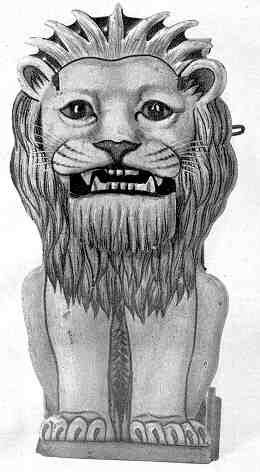British Lion (Tin)
by F.H. Griffith - HOBBIES Magazine - December, 1973
 Collecting mechanical banks just has to be one of the more
interesting and fascinating hobbies. There is no question but that the writer is
prejudiced in this direction, not, however, without sound good reasons to back up his
opinion. We will not attempt to go into all these at present — we will point up a
phase or two at this time.
Collecting mechanical banks just has to be one of the more
interesting and fascinating hobbies. There is no question but that the writer is
prejudiced in this direction, not, however, without sound good reasons to back up his
opinion. We will not attempt to go into all these at present — we will point up a
phase or two at this time.
Action is one of the keynotes. There always seems to be something going on. Then too the element of surprise enters the picture and this occurs at unplanned-for times. These two factors, action and surprise, greatly enhance the circumstances surrounding the continuing over the years efforts that one puts into collecting mechanical banks.
This brings us to the point of a completely unexpected surprise that happened to the writer recently — one of those pleasurable occasions that seem to come just at the right time. It all has to do with a mechanical bank that the writer knew existed, but it was the only one of all the known mechanicals that he had never seen. So to get to the point, it’s the British Lion (Tin) shown herewith. A fine all original mint condition example.
Let’s take a moment to explain that the British Lion was known to the writer years ago and existed in a collection that has now remained dormant for a long time. The example in this collection was the only one known to exist and this circumstance has remained unchanged over quite a few years until very recently. And then right out of the blue comes this fine British Lion pictured. Presently, of necessity, No. 230 in the numerical classification.
Due credit must first be given to the charming couple who found this bank. They are Nicole and Emmanuel Rodrigue of Paris, France. They share a very sincere interest in collecting the mechanicals and are personal friends of the writer. They mutually enjoy their hobby and they really work at it. They are a very interesting couple to know and converse with.
The British Lion, while not so marked, is of obvious German origin. As yet we do not know the manufacturer or the exact time period of the bank. At present we place it circa 1910 to 1930. This is a rather broad, but reasonably safe time period.
As to the colors of the bank, the figure of the lion is a typical lion color. The fine details of his mane and so on are done in shadings and lines of gray and black. These details, by the way, are exceptionally well done and very effective toward making it a most attractive interesting looking bank. The figure is on a small red base and the rectangular box coin section in back of the lion is also red. This section has a slide lock top for removal of coins. A large red tongue completes the colors of the bank.
The operation is quite effective. On pressing the lever on the left side of the bank the lower jaw of the lion moves down and a rather large curved red tongue protrudes well out of the mouth. The coin is placed thereon and releasing the lever causes all parts to return to position as shown in the photo. The effect, of course, the lion swallows the coin.
What more can be said? — Just this! — A December, 1936, monthly magazine, carried a well illustrated article on mechanical banks. This article by the late pioneer collector Andrew Emerine had a fine illustration of the British Lion, the only one known at the time. To the best of the writer’s knowledge the same circumstance, only one known, still existed some 36 years later! Wouldn’t it be interesting to know where the bank pictured has been all these years?
